Terraces of the Oh?e River in Žatec Area, Czech Republic: When Models of Holocene Fluvial Development Are Not Sufficient
Abstract
:1. Introduction
2. Study Area and Methods
2.1. Study Area
2.1.1. Geological Settings
2.1.2. Valley Morphology: Terraces
2.1.3. Anthropogenic Impacts
2.2. Methods
2.2.1. GIS Analysis
2.2.2. Geochemical Analyses
2.2.3. OSL Dating
3. Results
3.1. Geomorphic Description
3.2. OSL Ages
3.3. Sediment Geochemistry
3.4. Distribution of Sn-Contamination in Stage 0 Sediments
4. Discussion
4.1. Channel Pattern of the Ohře River Since the Late Pleistocene
4.2. Incision of the Ohře River Since the Late Pleistocene
4.3. Peculiarities of the Ingrown Meanders in Terrace Development
4.4. Peculiarities of the Holocene Evolution of the Ohře River Valley
4.5. The Anthropogenic Impact on the Ohře River Valley
4.6. Methodological Notes
4.7. Outlines of Future Research
5. Conclusions
Author Contributions
Funding
Institutional Review Board Statement
Informed Consent Statement
Data Availability Statement
Acknowledgments
Conflicts of Interest
References
- Cordier, S.; Briant, B.; Bridgland, D.; Herget, J.; Maddy, D.; Mather, A.; Vandenberghe, J. The Fluvial Archives Group: 20 years of research connecting fluvial geomorphology and palaeoenvironments. Quat. Sci. Rev. 2017, 166, 1–9. [Google Scholar] [CrossRef] [Green Version]
- Macklin, M.G.; Benito, G.; Gregory, K.J.; Johnstone, E.; Lewin, J.; Michczynska, D.J.; Soja, R.; Starkel, L.; Thomdycraft, V.R. Past hydrological events reflected in the Holocene fluvial record of Europe. Catena 2006, 66, 145–154. [Google Scholar] [CrossRef]
- Chiverell, R.C.; Thorndycraft, V.R.; Hoffmann, T.O. Cumulative probability functions and their role in evaluating the chronology of geomorphological events during the Holocene. J. Quat. Sci. 2011, 26, 76–85. [Google Scholar] [CrossRef]
- Oldknow, C.J.; Hooke, J.M. Alluvial terrace development and changing landscape connectivity in the Great Karoo, South Africa. Insights from the Wilgerbosch River catchment, Sneeuberg. Geomorphology 2017, 288, 12–38. [Google Scholar] [CrossRef] [Green Version]
- Faust, D.; Wolf, D. Interpreting drivers of change in fluvial archives of the Western Mediterranean—A critical view. Earth Sci. Rev. 2017, 174, 53–83. [Google Scholar] [CrossRef]
- Petit, F.; Hallot, E.; Houbrechts, G. The Semois Valley in Southern Ardenne: Short-Wavelength, Large-Amplitude Meanders Incised into a Slaty Basement. In Landscapes and Landforms of Belgium and Luxembourg; Demoulin, A., Ed.; Springer: Berlin/Heidelberg, Germany, 2018. [Google Scholar] [CrossRef]
- Rodriguez-Lloveras, X.; Machado, M.J.; Sanchez-Moya, Y.; Calle, M.; Medialdea, A.; Sopeña, A.; Benito, G. Impacts of sediment connectivity on Holocene alluvial records across a Mediterranean basin (Guadalentín River, SE-Spain). Catena 2020, 187, 104321. [Google Scholar] [CrossRef]
- Notebaert, B.; Broothaerts, N.; Verstraeten, G. Evidence of anthropogenic tipping points in fluvial dynamics in Europe. Glob. Planet. Chang. 2018, 164, 27–38. [Google Scholar] [CrossRef]
- Petřík, J.; Petr, L.; Adameková, K.; Prišťáková, M.; Potůčková, A.; Lenďáková, Z.; Frączek, M.; Dresler, P.; Macháček, J.; Kalicki, T.; et al. Disruption in an alluvial landscape: Settlement and environment dynamics on the alluvium of the river Dyje at the Pohansko archaeological site. Quat. Intern. 2019, 511, 124–139. [Google Scholar] [CrossRef]
- Matys Grygar, T.; Nováková, T.; Mihaljevič, M.; Strnad, L.; Světlík, I.; Koptíková, L.; Lisá, L.; Brázdil, R.; Máčka, Z.; Stachoň, Z.; et al. Surprisingly small increase of the sedimentation rate in the floodplain of Morava River in the Strážnice area, Czech Republic, in the last 1300 years. Catena 2011, 86, 192–207. [Google Scholar] [CrossRef]
- Bradley, D.N.; Tucker, G.E. The storage time, age, and erosion hazard of laterally accreted sediment on the floodplain of a simulated meandering river. J. Geophys. Res. Earth Surf. 2013, 118, 1308–1319. [Google Scholar] [CrossRef]
- Limaye, A.B.S.; Lamb, M.P. Numerical model predictions of autogenic fluvial terraces and comparison to climate change expectations. J. Geophys. Res. Earth Surf. 2016, 121, 512–544. [Google Scholar] [CrossRef] [Green Version]
- Malatesta, L.C.; Prancevic, J.P.; Avouac, J.-P. Autogenic entrenchment patterns and terraces due to coupling with lateral erosion in incising alluvial channels. J. Geophys. Res. Earth Surf. 2017, 122, 335–355. [Google Scholar] [CrossRef]
- Tofelde, S.; Savi, S.; Wickert, A.D.; Bufe, A.; Schildgen, T.F. Alluvial channel response to environmental perturbations: Fill-terrace formation and sediment-signal disruption. Earth Surf. Dynam. 2019, 7, 609–631. [Google Scholar] [CrossRef] [Green Version]
- Matys Grygar, T.; Elznicová, J.; Kiss, T.; Smith, H.G. Using sedimentary archives to reconstruct pollution history and sediment provenance: The Ohře River, Czech Republic. Catena 2016, 144, 109–129. [Google Scholar] [CrossRef]
- Elznicová, J.; Kiss, T.; Sipos, G.; Faměra, M.; Štojdl, J.; Váchová, V.; Matys Grygar, T. A central European alluvial river under anthropogenic pressure: The Ohře River, Czechia. Catena 2021, 201, 105218. [Google Scholar] [CrossRef]
- Brown, A.G.; Lespez, L.; Sear, D.A.; Macaire, J.-J.; Houben, P.; Klimek, K.; Brazier, R.E.; Van Oost, K.; Pears, B. Natural vs anthropogenic streams in Europe: History, ecology and implications for restoration, river-rewilding and riverine ecosystem services. Earth Sci. Rev. 2018, 180, 185–205. [Google Scholar] [CrossRef]
- Engelmann, R. Die Entstehung des Egertales. In Abhandlungen der Geographischen Gesellschaft in Wien; Geographische Gesellschaft in Wien: Wien, Austria, 1922; Volume 12, pp. 1–80. [Google Scholar]
- Balatka, B.; Červinka, P. Geomorfologická analýza a vývoj údolních meandrů Ohře v mostecké pánvi (Geomorphological analysis and development of Ohře River valley meanders in the Mostecká pánev (Basin)). Sborník České Geogr. Společnosti 1994, 99, 234–247, ISSN 0231-5300. [Google Scholar]
- Tyráček, J. Stratigraphy of the Ohre River terraces in the Most Basin. Sborník Geol. Věd Antropozoikum 1995, 22, 141–157, ISBN 80-7075-184-3. [Google Scholar]
- Tyráček, J. Upper Cenozoic fluvial history in the Bohemian Massif. Quat. Intern. 2001, 79, 37–53. [Google Scholar] [CrossRef]
- Starkel, L.; Gębica, P.; Superson, J. Last Glacial–Interglacial cycle in the evolution of river valleys in southern and central Poland. Quat. Sci. Rev. 2007, 26, 2924–2936. [Google Scholar] [CrossRef] [Green Version]
- Vandenberghe, J. River terraces as a response to climatic forcing: Formation processes, sedimentary characteristics and sites for human occupation. Quat. Intern. 2015, 370, 3–11. [Google Scholar] [CrossRef]
- Winsemann, J.; Lang, J.; Roskosch, J.; Polom, U.; Böhner, U.; Brandes, C.; Glotzbach, C.; Frechen, M. Terrace styles and timing of terrace formation in the Weser and Leine valleys, northern Germany: Response of a fluvial system to climate change and glaciation. Quat. Sci. Rev. 2015, 123, 31–57. [Google Scholar] [CrossRef]
- Zieliński, T.; Terpiłowski, S.; Zieliński, P.; Pidek, I.A.; Godlewska, A.; Czubla, P. What was an interglacial river like? Sedimentological investigation of Holsteinian fluvial deposits in eastern Poland. Geol. Q. 2016, 60, 149–166. [Google Scholar] [CrossRef] [Green Version]
- Wójcicki, K.J.; Pawelec, H.; Malik, I.; Woskowicz-Ślęzak, B.; Moska, P. Erosion and accumulation phases during the last glacial-interglacial cycle: A case study of the terrace system of the Odra and Osobłoga rivers (southern Poland). Geol. Q. 2020, 64, 104–119. [Google Scholar] [CrossRef]
- Kermode, S.J.; Cohen, T.J.; Reinfelds, I.V.; Nanson, G.C.; Pietsch, T.J. Alluvium of antiquity: Polycyclic terraces in a confined bedrock valley. Geomorphology 2012, 139, 471–483. [Google Scholar] [CrossRef]
- Keen-Zebert, A.; Hudson, M.R.; Shepherd, S.L.; Thaler, E.A. The effect of lithology on valley width, terrace distribution, and bedload provenance in a tectonically stable catchment with flat-lying stratigraphy. Earth Surf. Process. Landf. 2017, 42, 1573–1587. [Google Scholar] [CrossRef]
- Rixhon, G.; Braucher, R.; Bourlès, D.; Siame, L.; Bovy, B.; Demoulin, A. Quaternary river incision in NE Ardennes (Belgium)-Insights from 10Be/26Al dating of river terraces. Quat. Geochronol. 2011, 6, 273–284. [Google Scholar] [CrossRef] [Green Version]
- Schaller, M.; Ehlers, T.A.; Stor, T.; Torrent, J.; Lobato, L.; Christl, M.; Vockenhuber, C. Timing of European fluvial terrace formation and incision rates constrained by cosmogenic nuclide dating. Earth Planet. Sci. Lett. 2016, 451, 221–231. [Google Scholar] [CrossRef]
- Fikarová, J.; Kříženecká, S.; Elznicová, J.; Faměra, M.; Lelková, T.; Matkovič, J.; Matys Grygar, T. Spatial distribution of organic pollutants (PAHs and polar pesticides) in the floodplain of the Ohře (Eger) River, Czech Republic. J. Soils Sediments 2018, 18, 259–275. [Google Scholar] [CrossRef]
- Matys Grygar, T.; Elznicová, J.; Lelková, T.; Kiss, T.; Balogh, M.; Strnad, L.; Navrátil, T. Sedimentary archive of contamination in the confined channel of the Ohře River, Czech Republic. J. Soils Sediments 2017, 17, 2596–2609. [Google Scholar] [CrossRef]
- Matys Grygar, T.; Bábek, O.; Sedláček, J.; Lenďáková, Z.; Faměra, M.; Štojdl, J.; Pacina, J.; Tolaszová, J.; Kříženecká, S. Segregation and retention of As, potentially toxic metals, and organic pollutants in a reservoir from the Ohře River (the Czech Republic). J. Soils Sediments 2020, 20, 2931–2948. [Google Scholar] [CrossRef]
- Rajchl, M.; Uličný, D.; Grygar, R.; Mach, K. Evolution of basin architecture in an incipient continental rift: The Cenozoic Most Basin, Eger Graben (Central Europe). Basin Res. 2009, 21, 269–294. [Google Scholar] [CrossRef]
- Holodňák, P. Labyrintem Žateckého pravěku (Through Labyrinth of Žatec Prehistory); Studie regionálního muzea v Žatci: Žatec, Czech Republic, 2006; ISBN 80-86971-18-X. [Google Scholar]
- Tolksdorf, J.F.; Kaiser, K.; Petr, L.; Herbig, C.; Kočár, P.; Heinrich, S.; Wilke, F.D.H.; Theuerkauf, M.; Fülling, A.; Schubert, M.; et al. Past human impact in a mountain forest: Geoarchaeology of a medieval glass production and charcoal hearth site in the Erzgebirge, Germany. Reg. Environ. Chang. 2020, 20, 1–12. [Google Scholar] [CrossRef]
- Majerová, L.; Bábek, O.; Navrátil, T.; Nováková, T.; Štojdl, J.; Elznicová, J.; Hron, K.; Matys Grygar, T. Dam reservoirs as an efficient trap for historical pollution: The passage of Hg and Pb through the Ohře River, Czech Republic. Environ. Earth Sci. 2018, 77, 1–12. [Google Scholar] [CrossRef]
- Hošek, M.; Matys Grygar, T.; Elznicová, J.; Faměra, M.; Popelka, J.; Matkovič, J.; Kiss, T. Geochemical mapping in polluted floodplains using in situ X-ray fluorescence analysis, geophysical imaging, and statistics: Surprising complexity of floodplain pollution hotspot. Catena 2018, 171, 632–644. [Google Scholar] [CrossRef]
- Rudnick, R.; Gao, S. Composition of the continental crust. In The Crust; Treatise on Geochemistry 3; Rudnick, R.L., Holland, H.D., Turekian, K.K., Eds.; Elsevier–Pergamon: Oxford, UK, 2003; pp. 1–64. [Google Scholar]
- Matschullat, J.; Ottenstein, R.; Reiman, C. Geochemical background—Can we calculate it? Environ. Geol. 2000, 39, 990–1000. [Google Scholar] [CrossRef]
- Sipos, G.; Kiss, T.; Tóth, O. Constraining the age of floodplain levels along the lower section of River Tisza, Hungary. J. Environ. Geogr. 2016, 9, 39–44. [Google Scholar] [CrossRef] [Green Version]
- Tóth, O.; Sipos, G.; Kiss, T.; Bartyik, T. Variation of OSL residual doses in terms of coarse and fine grain modern sediments along the Hungarian section of the Danube. Geochronometria 2017, 44, 319–330. [Google Scholar] [CrossRef] [Green Version]
- Murray, A.S.; Wintle, A.G. The single 847 aliquot regenerative dose protocol: Potential for improvements in reliability. Radiat. Meas. 2003, 37, 377–381. [Google Scholar] [CrossRef]
- Wintle, A.G.; Murray, A.S. A review of quartz optically stimulated luminescence characteristics and their relevance in single-aliquot regeneration dating protocols. Radiat. Meas. 2006, 41, 369–391. [Google Scholar] [CrossRef]
- Galbraith, R.F.; Roberts, R.G.; Laslett, G.M.; Yoshida, H.; Olley, J.M. Optical dating of single and multiple grains of quartz from Jinmium Rock Shelter, northern Australia: Part 1, experimental design and statistical models. Archaeometry 1999, 41, 339–364. [Google Scholar] [CrossRef]
- Liritzis, I.; Stamoulis, K.; Papachristodoulou, C.; Ioannides, K. A re-evaluation of radiation dose-rate conversion factors. Mediterr. Archaeol. Archaeom. 2013, 13, 1–15. [Google Scholar]
- Brennan, B.J. Beta doses to spherical grains. Radiat. Meas. 2003, 37, 299–303. [Google Scholar] [CrossRef]
- Aitken, M.J. Thermoluminescence Dating; Academic Press: London, UK, 1985; p. 351. ISBN 0-12-046380-6. [Google Scholar]
- Prescott, J.R.; Hutton, J.T. Cosmic ray contributions to dose rates for luminescence and ESR dating: Large depths and long term variations. Radiat. Meas. 1994, 23, 497–500. [Google Scholar] [CrossRef]
- Kiss, T.; Hernesz, P.; Sipos, G. Meander cores on the floodplain—The Early Holocene development of the low-floodplain along the lower Tisza region, Hungary. J. Env. Geogr. 2012, 5, 1–10. [Google Scholar]
- Kondolf, G.M. Hungry Water: Effects of dams and gravel mining on river channels. Env. Manag. 1997, 21, 533–551. [Google Scholar] [CrossRef] [PubMed]
- Matys Grygar, T.; Mach, K.; Martinez, M. Checklist for the use of potassium concentrations in siliciclastic sediments as paleoenvironmental archives. Sedim. Geol. 2019, 382, 75–84. [Google Scholar] [CrossRef] [Green Version]
- Matys Grygar, T.; Popelka, J. Revisiting geochemical methods of distinguishing natural concentrations and pollution by risk elements in fluvial sediments. J. Geochem. Explor. 2016, 170, 39–57. [Google Scholar] [CrossRef]
- Kiss, T.; Sümeghy, B.; Sipos, G. Late Quaternary paleodrainage reconstruction of the Maros River alluvial fan. Geomorphology 2014, 204, 49–60. [Google Scholar] [CrossRef]
- Kasse, C.; Van Balen, R.T.; Bohncke, S.J.P.; Wallinga, J.; Vreugdenhil, M. Climate and base-level controlled fluvial system change and incision during the last glacial–interglacial transition, Roer River, the Netherlands—Western Germany. Neth. J. Geosci. Geol. Mijnb. 2017, 96, 71–92. [Google Scholar] [CrossRef] [Green Version]
- Vandenberghe, J.; Kasse, C.; Popov, D.; Markovic, S.B.; Vandenberghe, D.; Bohncke, S.; Gabris, G. Specifying the external impact on fluvial lowland evolution: The Last Glacial Tisza (Tisa) catchment in Hungary and Serbia. Quaternary 2018, 1, 14. [Google Scholar] [CrossRef] [Green Version]
- Vandenberghe, J.; Woo, M.-K. Modern and ancient periglacial river types. Progr. Phys. Geogr. 2002, 26, 479–506. [Google Scholar] [CrossRef]
- Dobrzańska, H.; Kalicki, T. Morphology and land use of floodplains in the western part of Sandomierz Basin (southern Poland, Central Europe) in the Roman period. Quat. Intern. 2015, 370, 100–112. [Google Scholar] [CrossRef]
- Panin, A.; Adamiec, G.; Buylaert, J.-P.; Matlakhova, E.; Moska, P.; Novenko, E. Two Late Pleistocene climate-driven incision/aggradation rhythms in the middle Dnieper River basin, west-central Russian Plain. Quat. Sci. Rev. 2017, 166, 266–288. [Google Scholar] [CrossRef] [Green Version]
- Woolderink, H.A.G.; Kasse, C.; Grooteman, L.P.A.; Van Balen, R.T. Interplay between climatic, tectonic and anthropogenic forcing in the Lower Rhine Graben, the Roer River. Geomorphology 2019, 344, 25–45. [Google Scholar] [CrossRef]
- Starkel, L.; Michczyńska, D.J.; Gębica, P.; Kiss, T.; Panin, A.; Perşoiu, I. Climatic fluctuations reflected in the evolution of fluvial systems of Central-Eastern Europe (60-8 ka cal BP). Quat. Intern. 2015, 388, 97–118. [Google Scholar] [CrossRef]
- Kadlec, J.; Kocurek, G.; Mohrig, D.; Shinde, D.P.; Murari, M.K.; Varma, V.; Stehlík, F.; Beneš, V.; Singhvi, A.K. Response of fluvial, aeolian, and lacustrine systems to late Pleistocene to Holocene climate change, Lower Moravian Basin, Czech Republic. Geomorphology 2015, 232, 193–208. [Google Scholar] [CrossRef]
- Schulte, L.; Julia, R.; Burjachs, F.; Hilgers, A. Middle Pleistocene to Holocene geochronology of the River Aguas terrace sequence (Iberian Peninsula): Fluvial response to Mediterranean environmental change. Geomorphology 2008, 98, 13–33. [Google Scholar] [CrossRef]
- Daley, J.S.; Cohen, T.J. Climatically-controlled river terraces in Eastern Australia. Quaternary 2018, 1, 23. [Google Scholar] [CrossRef] [Green Version]
- Kalicki, T.; Frączek, M.; Przepióra, P.; Kusztal, P.; Kłusakiewicz, E.; Malęga, E. Late Quaternary geomorphology and geoarchaeology in the rivers of the Holy Cross Mountains region, central Europe. Quat. Res. 2019, 91, 584–599. [Google Scholar] [CrossRef]
- Peng, F.; Prins, M.A.; Kasse, C.; Cohen, K.M.; Van der Putten, N.; van der Lubbe, J.; Toonen, W.H.J.; van Balen, R.T. An improved method for paleoflood reconstruction and flooding phase identification, applied to the Meuse River in the Netherlands. Glob. Planet. Chang. 2019, 177, 213–224. [Google Scholar] [CrossRef]
- Lombardi, R.; Davis, L.; Stinchomb, G.E.; Munoz, S.E.; Stewart, L.; Therrell, M.D. Fluvial activity in major river basins of the eastern United States during the Holocene. Holocene 2020, 30, 1279–1295. [Google Scholar] [CrossRef]
- Váchová, V. Hodnocení vývoje řeky Ohře mezi obcemi Žatec a Postoloprty (Evaluation of the development of the Ohře River between cities of Žatec and Postoloprty). Master’s Thesis, Faculty of Environment, J.E. Purkyně University in Ústí nad Labem, Ústí nad Labem, Czech Republic, 2016. [Google Scholar]
- Pacina, J.; Lenďáková, Z.; Štojdl, J.; Matys Grygar, T.; Dolejš, M. Dynamics of Sediments in Reservoir Inflows: A Case Study of the Skalka and Nechranice Reservoirs, Czech Republic. ISPRS Intern. J. Geo-Inf. 2020, 9, 258. [Google Scholar] [CrossRef] [Green Version]
- Maaß, A.-L.; Schüttrumpf, H. Reactivation of floodplains in river restorations: Long-term implications on the mobility of floodplain sediment deposits. Water Resour. Res. 2019, 55, 8178–8196. [Google Scholar] [CrossRef]
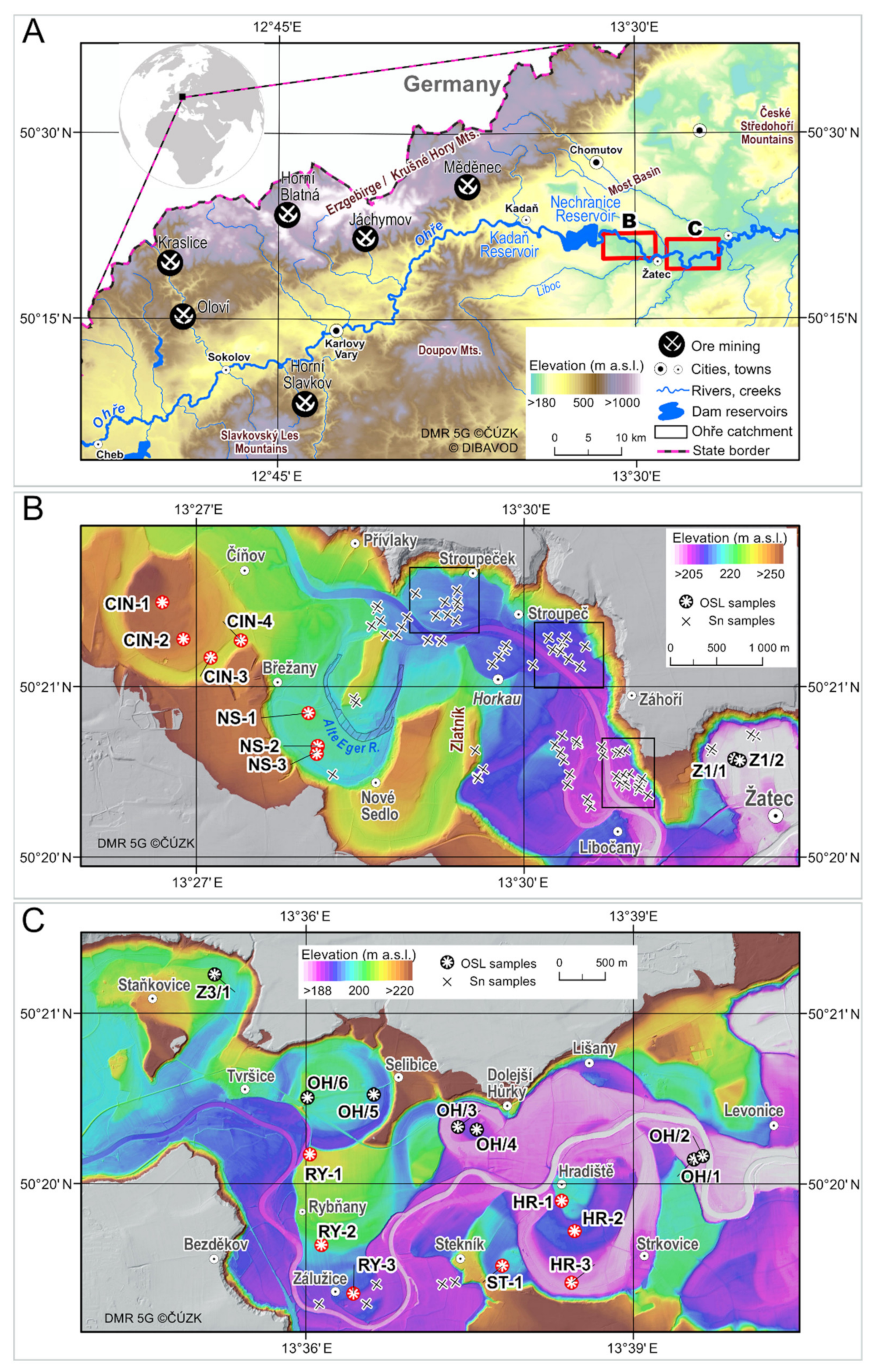
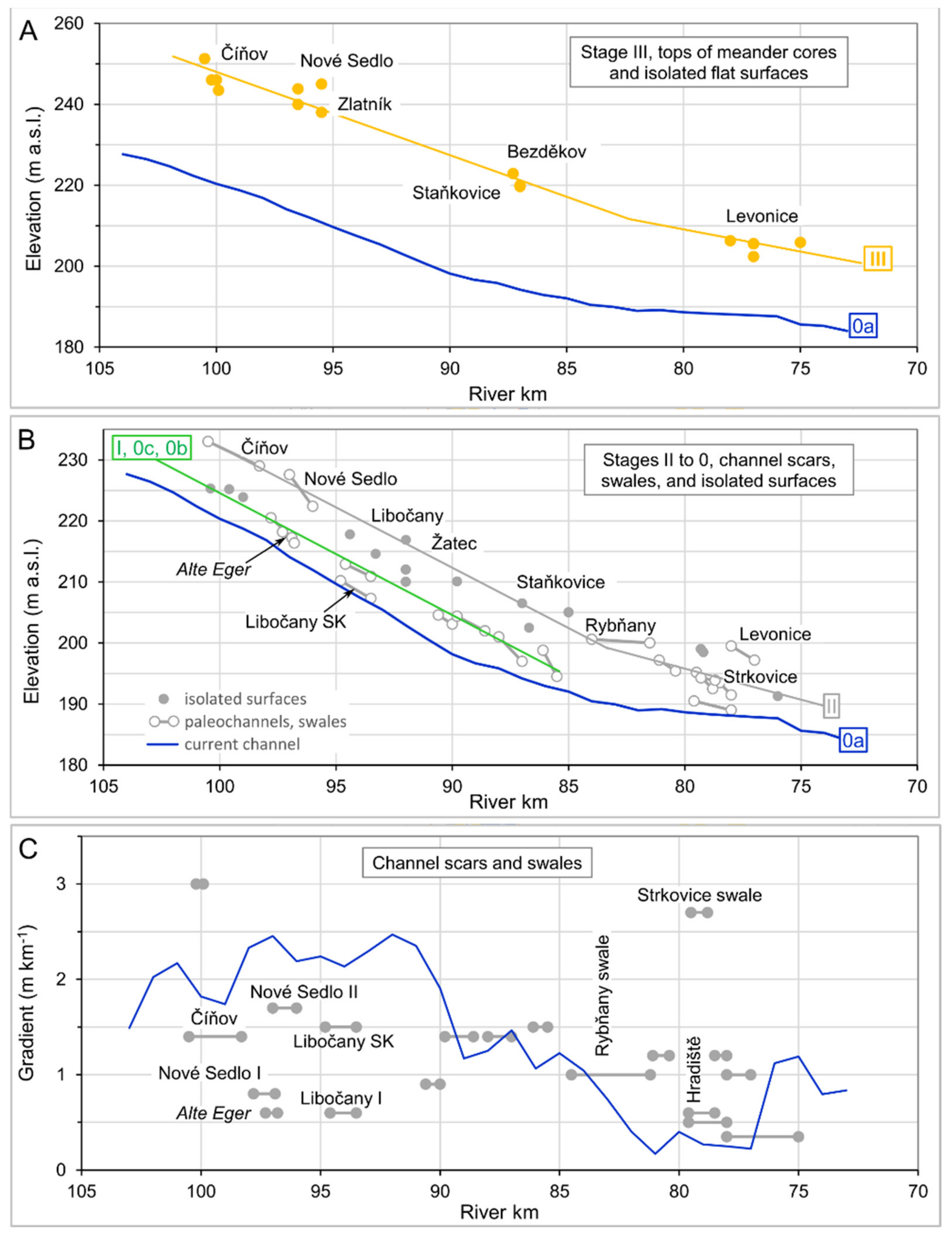
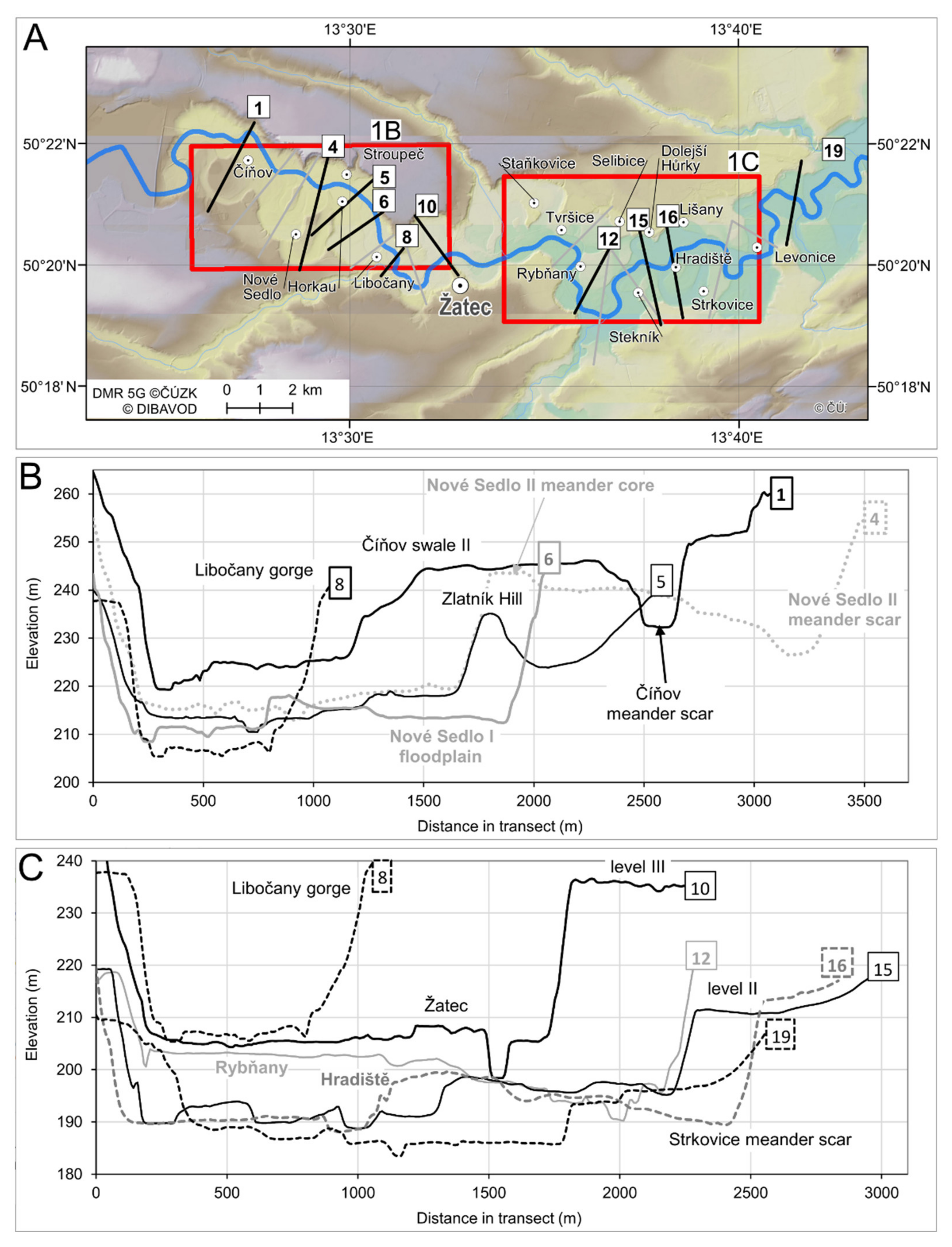


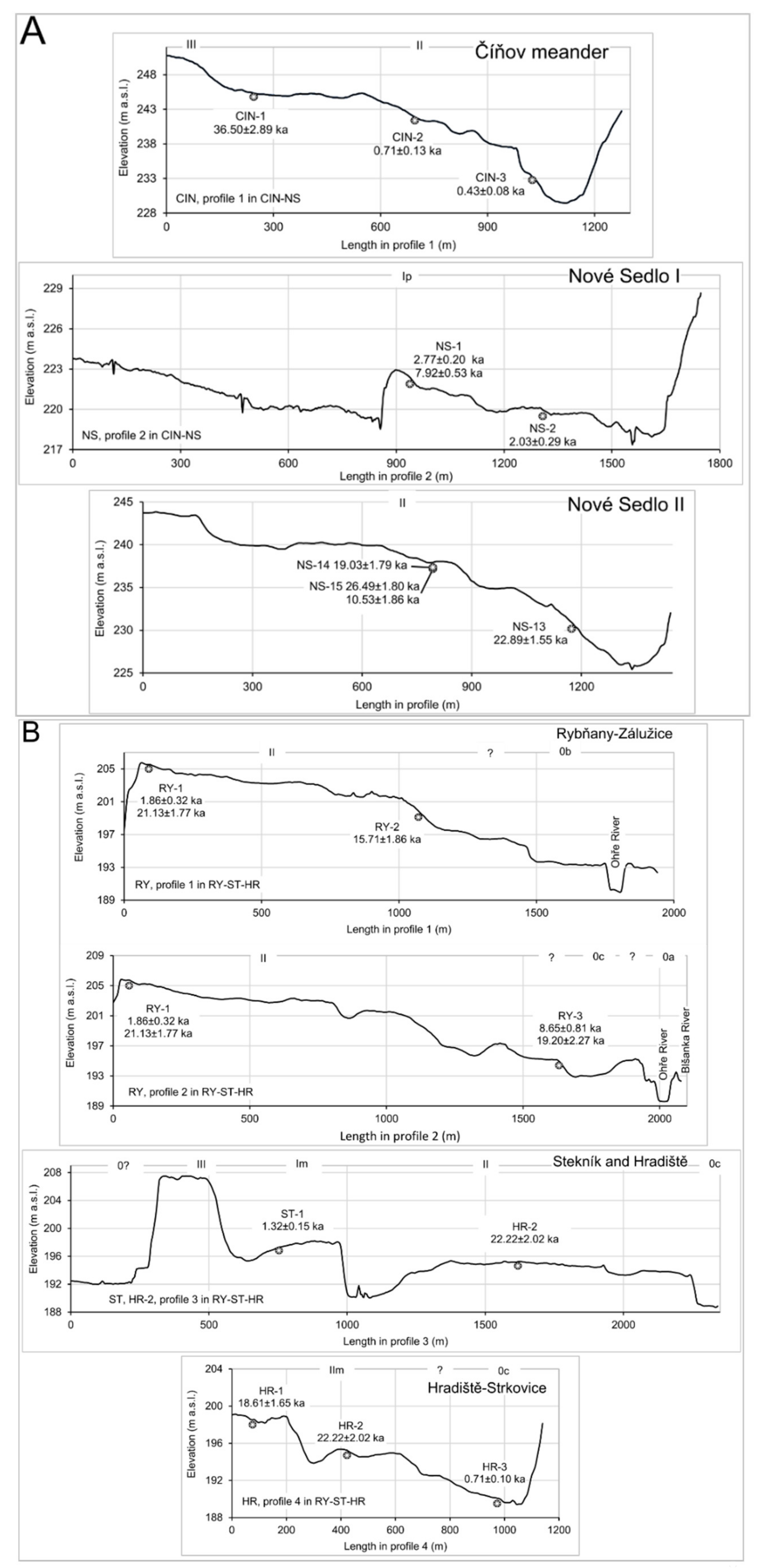
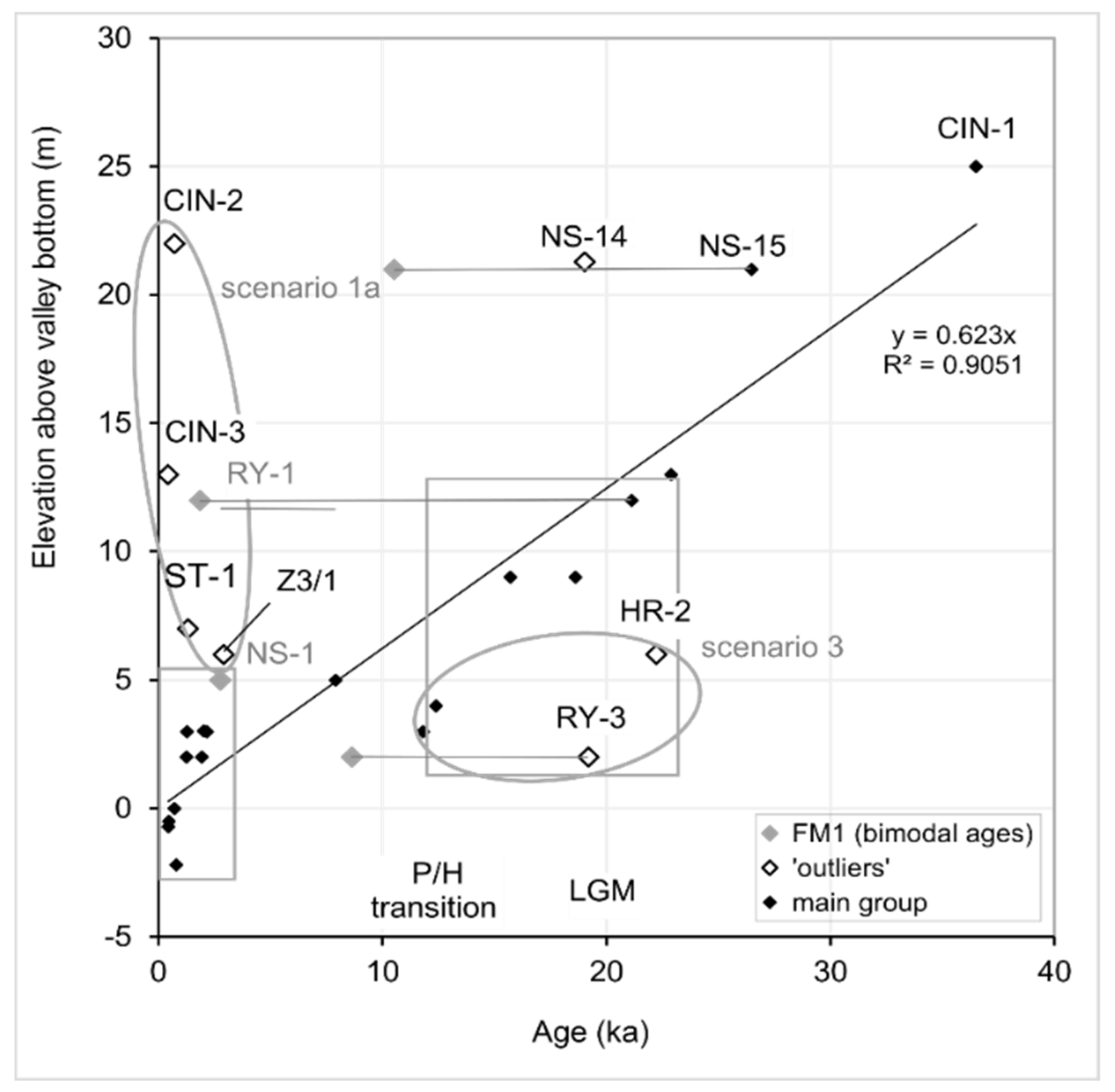

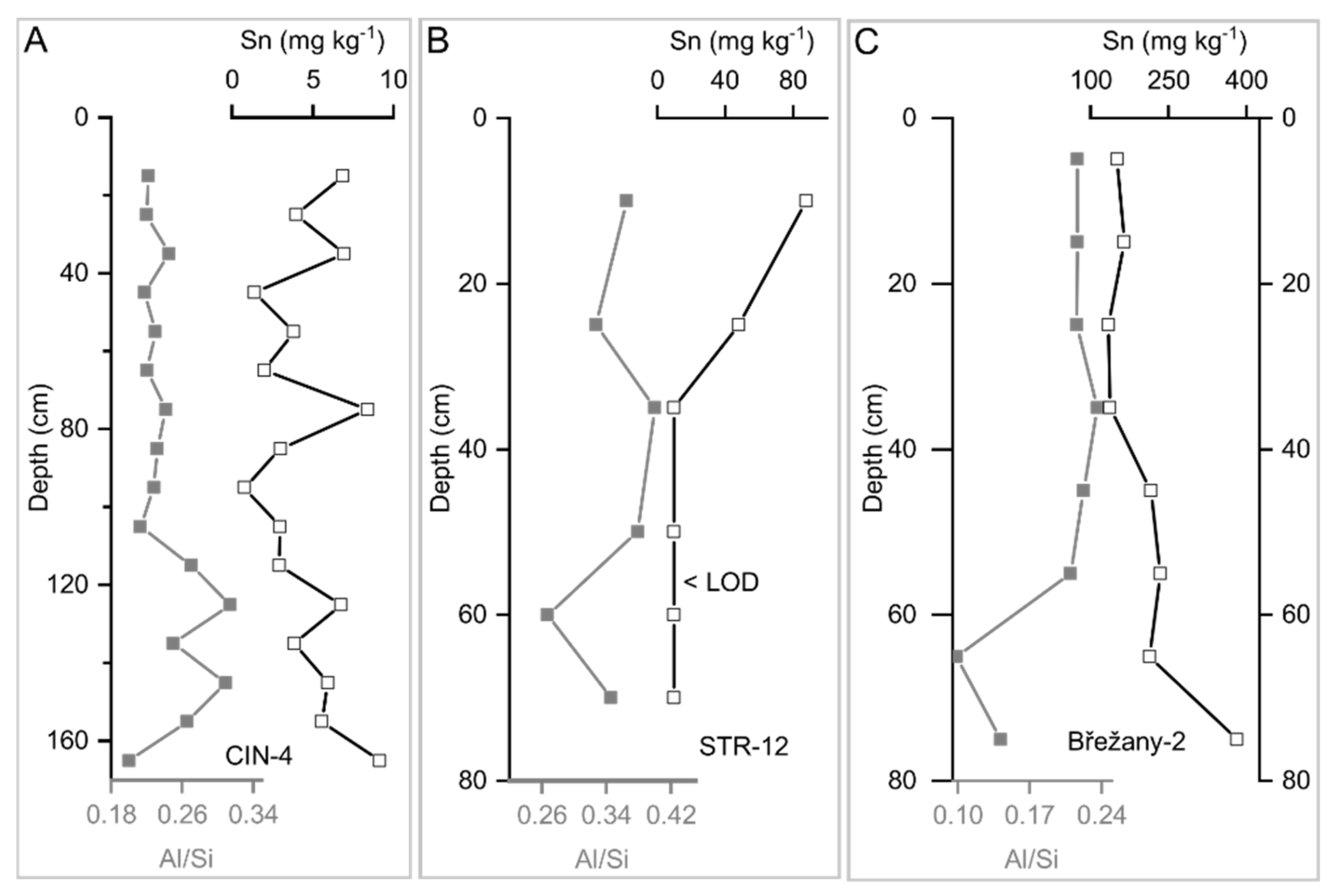



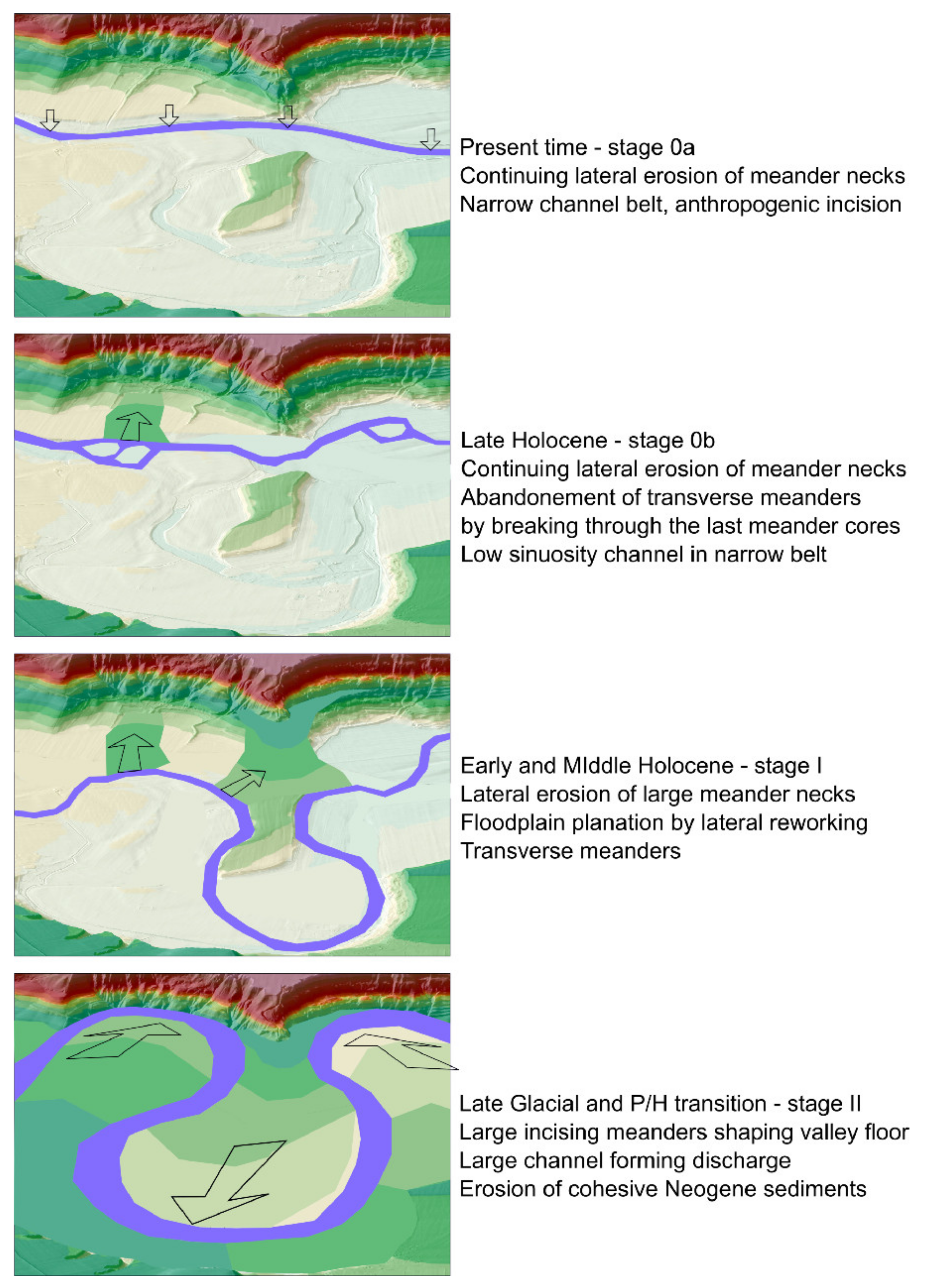
| Level/ Stage | Features of Channels and Surface Sediments | Age (Number of OSL Ages) | Relative Elevation (m) | Channel Width/ Meander Radii (m) |
|---|---|---|---|---|
| 0a | Current channel belt, in places engineered, laterally stable or wandering channel (no meandering), coarse-grained sediments (no silts), deepest incised meander belt (Figure 2 and Figure 5) | 20th century | 0 | 64(10)/n.p. 1 54(9)/n.p. 2 |
| 0b | Subrecent (pre-engineered) channel belt, with lateral deposits covered by overbank fines, Sn-contaminated, laterally reworked overbank sediments, wandering channel, e.g. Libočany SK (Figure 5B) | Post-16th century (2) | 0–3 | 85(13)/n.p. 1 72(9) /n.p. 2 |
| 0c | Subrecent (pre-engineered) channel belt, with uncontaminated channel deposits covered by Sn-contaminated overbank fines or channel fills, laterally reworked overbank sediments, wandering channel (Figure 5B) | Pre-16th century (2) | 0–3 | |
| Ip | Channel belts with transverse (passive) meanders, sandy deposits covered by silty overbank fines, no Sn contamination, rather fine sediments (sandy and silty), upstream Žatec, meanders at Nové Sedlo I, Alte Eger, Libočany I. (Figure 1B, Figure 4, and Figure 6) | Middle/Late Holocene (4) | 2–4 | 40–50/n.p. |
| Im | Genuine meanders of a small diameter abandoned by subsequent incision of channel belt 0, downstream Žatec: Selibice, Dolejší Hůrky, Stekník (Figure 1C, Figure 2B, Figure 3C, and Figure 6) | Middle/Late Holocene (5) | 2–5 | 90/250 |
| IIm | Channels with large incising (ingrown) meanders, coarse sediments with sand matrix and pebbly admixtures, no silts, downstream Žatec: Staňkovice, Rybňany-Zálužice, Hradiště-Strkovice, (Figure 1C, Figure 2B, Figure 3C, and Figure 6) | LGM (6) | 5–7 | 130–200/550–900 |
| IIm | Incising (ingrown) meanders of a large diameter, coarse sediments (coarse sand to cobbles), no silts, upstream Žatec: Číňov, Nové Sedlo II, (Figure 1B, Figure 2B, Figure 3B and Figure 6) | LGM (3) | 10–20 | 140–170/600–740 |
| III | Figure 2A, terrace level above stage II, elevation parallel with current channel belt, preserved mostly as flat strips around incised valley level II, also tops of some meander cores of stage II, possibly remnants of braided plain, around Žatec | Late Pleistocene (1) | 20–30 |
| Field ID | Description | Location (Meander Name) | Age (ka) | Elevation (m) |
|---|---|---|---|---|
| Z3/1 | Last point bar of a big palaeomeander | Staňkovice | 2.91 ± 0.31 | 6 |
| OH6 | Core of cut-off palaeomeander | Selibice | 12.39 ± 0.70 | 4 |
| OH5 | Last point bar of preceding | 2.16 ± 0.43 | 3 | |
| OH4 | Core of cut-off palaeomeander | Dolejší Hůrky | 1.94 ± 0.28 | 2 |
| OH3 | Last point bar of preceding | 1.26 ± 0.17 | 2 |
| Field ID | Lab. ID | Location (Meander Name) | Depth (cm) | Age Model | Age (ka) | Sn Contamination | Elevation (m) |
|---|---|---|---|---|---|---|---|
| CIN-1 | OSZ 1830 | Číňov | 50 | CAM | 36.50±2.89 | N.A. | 25 |
| CIN-2 | OSZ 1831 | 50 | MAM | 0.71±0.13 | N.A. | 22 | |
| CIN-3 | OSZ 1832 | 50 | MAM | 0.43±0.08 | No | 13 | |
| NS-1 | OSZ 1833 | Nové Sedlo I | 50 | FM1 | 2.77±0.20 | N.A. | 5 |
| FM2 | 7.92±0.53 | ||||||
| NS-2 | OSZ 1834 | 50 | MAM | 2.03±0.29 | No | 3 | |
| RY-1 | OSZ 1823 | Rybňany-Zálužice | 50 | FM1 | 1.86±0.32 | N.A. | 12 |
| FM2 | 21.13±1.77 | ||||||
| RY-2 | OSZ 1824 | 50 | MAM | 15.71±1.86 | N.A. | 9 | |
| RY-3 | OSZ 1825 | 50 | FM1 | 8.65±0.81 | N.A. | 2 | |
| FM2 | 19.20±2.27 | ||||||
| ST-1 | OSZ 1829 | Stekník | 50 | MAM | 1.32±0.15 | N.A. | 7 |
| HR-1 | OSZ 1826 | Hradiště-Strkovice | 60 | CAM | 18.61±1.65 | N.A. | 9 |
| HR-2 | OSZ 1827 | 70 | MAM | 22.22±2.02 | N.A. | 6 | |
| HR-3 | OSZ 1828 | 50 | MAM | 0.71±0.10 | Yes | 0 | |
| LIB-13 | OST 2019 | Libočany I | 100 | MAM | 11.82±0.53 | No | 3 |
| NS-13 | OSZ 2023 | Nové Sedlo II | 30 | MAM | 22.89±1.55 | N.A. | 13 |
| NS-14 | OSZ 2024 | 50 | MAM | 19.03±1.79 | N.A. | 21 | |
| NS-15 | OSZ 2025 | 70 | FM1 | 26.49±1.8 | N.A. | 21 | |
| FM2 | 10.53±1.06 | ||||||
| NS-16 | OSZ 2026 | Alte Eger | 85 | MAM | 1.28±0.09 | Yes | 3 |
| Problem | Scenario | Contra-Arguments, Doubts | Supportive Arguments | Action |
|---|---|---|---|---|
| Too young ages at high elevations | (1a) Recent post-depositional mixing | Fine mass between imbricated pebbles to cobbles (channel armour) was sampled. Recent surface processes have not been sufficiently intensive to rework/re-order clasts. | Absence of Sn-contamination in some sediments with too young OSL ages (CIN-4 at even lower elevation than CIN-3). | Discarding the results |
| Bimodal distribution of ages – component FMM1 is too young | (1b) Lateral sediment reworking in Late Glacial, with part of the reworked material not bleached | The ingrown meanders do not show much reworking or deposition The Quaternary cover is too thin and fining upward to indicate floodplain fill reworking [16] | Use older ages in FM model | |
| Bimodal distribution of ages—the older ages (FM2 component in FM model) | (2) Insufficient bleaching of a fraction of sediments | Surfaces of point bars were sampled, with a good chance for having been bleached under low discharges | Too dense suspension in coarse bedload of event-like deposition could prevent bleaching | Use younger ages in FM model |
| Reverse order of Late Glacial ages with respect to elevation | (3) Late Glacial non-conformity, i.e., fluctuating erosion base (quickly repeating erosion and deposition) | Such mechanism has not been described yet | The study area has settings resembling alluvial fan, where authigenic cycles (avulsions, reworking) are common | Further study is needed |
Publisher’s Note: MDPI stays neutral with regard to jurisdictional claims in published maps and institutional affiliations. |
© 2021 by the authors. Licensee MDPI, Basel, Switzerland. This article is an open access article distributed under the terms and conditions of the Creative Commons Attribution (CC BY) license (https://creativecommons.org/licenses/by/4.0/).
Share and Cite
Grygar, T.M.; Elznicová, J.; Sipos, G.; Kiss, T. Terraces of the Oh?e River in Žatec Area, Czech Republic: When Models of Holocene Fluvial Development Are Not Sufficient. Geosciences 2021, 11, 210. https://doi.org/10.3390/geosciences11050210
Grygar TM, Elznicová J, Sipos G, Kiss T. Terraces of the Oh?e River in Žatec Area, Czech Republic: When Models of Holocene Fluvial Development Are Not Sufficient. Geosciences. 2021; 11(5):210. https://doi.org/10.3390/geosciences11050210
Chicago/Turabian StyleGrygar, Tomáš Matys, Jitka Elznicová, György Sipos, and Tímea Kiss. 2021. "Terraces of the Oh?e River in Žatec Area, Czech Republic: When Models of Holocene Fluvial Development Are Not Sufficient" Geosciences 11, no. 5: 210. https://doi.org/10.3390/geosciences11050210
APA StyleGrygar, T. M., Elznicová, J., Sipos, G., & Kiss, T. (2021). Terraces of the Oh?e River in Žatec Area, Czech Republic: When Models of Holocene Fluvial Development Are Not Sufficient. Geosciences, 11(5), 210. https://doi.org/10.3390/geosciences11050210







